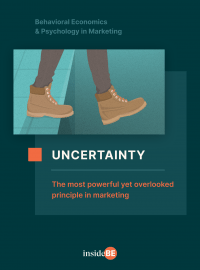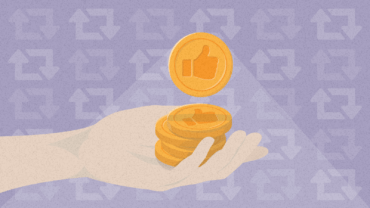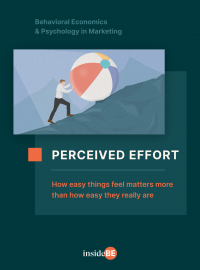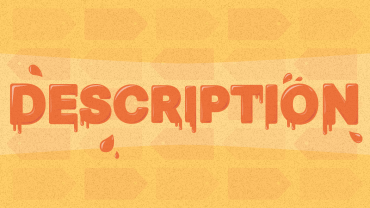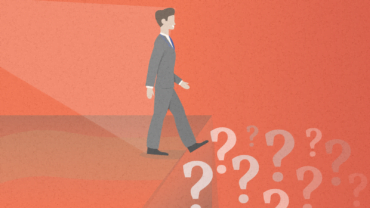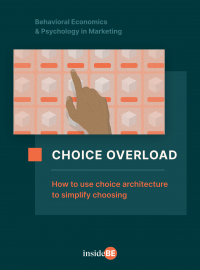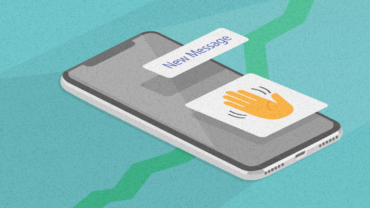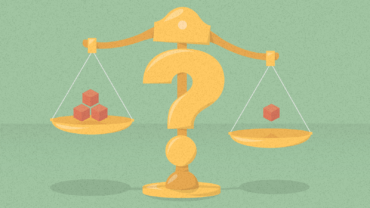The 5 Stages of the Consumer Buying Process and How Psychology Influences Them
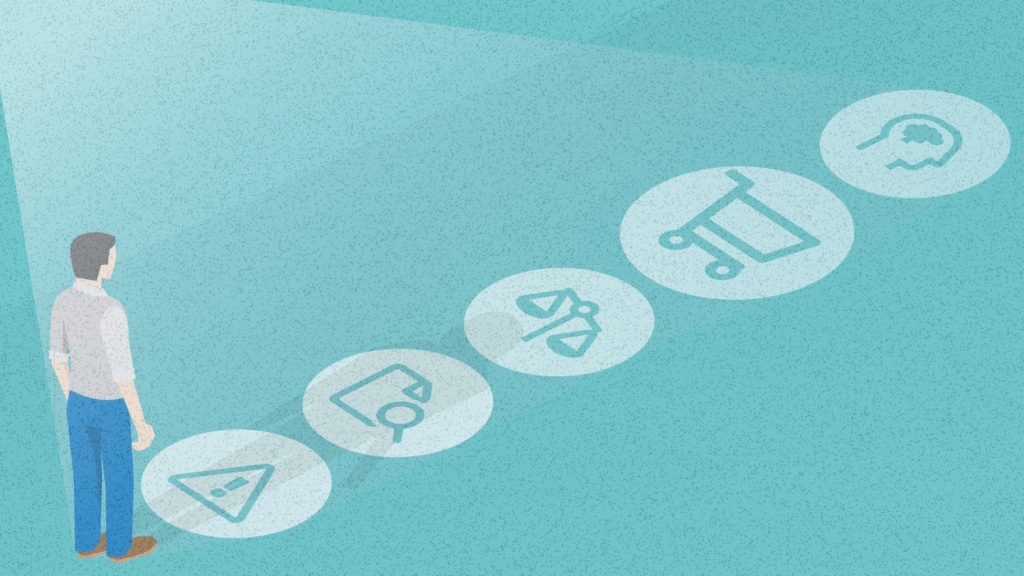
What do buying a car and buying a bar of chocolate have in common? Well, the process consumers go through in their heads to reach their purchase decision is the same. It’s called the consumer buying process and it’s loaded with consumer psychology insights.
Article content:
Hola, marketer. Bonjour, sales manager. You’ve probably come here asking yourself, “What’s the consumer buying process?” For starters, we’ll give it to you plain and simple. The consumer buying process is the 5 stages a person goes through to make a purchase decision.
Stages of Consumer Buying Decision Process:
- Problem recognition
- Information gathering
- Evaluation of options
- Purchase
- Post-purchase
That’s the textbook definition of the consumer buying process. But people don’t go through it consciously and nobody actually runs through that checklist in their head. The consumer buying process is actually a concept invented by marketers to better understand how to convince their consumers to buy their product.
Most purchase decisions run on autopilot — buy the milk with the red label. Non-conscious decision-making informs the majority of purchases and are highly impacted by purchase context. That’s why marketers must find a way to speak to the subconscious brain.
Customers consider price as a vital factor influencing their purchase decision process. If you’d like to learn more about its importance, check out the article from our friends at Taylor Wells.
Below you’ll find each stage of the consumer buying process explained in detail along with insight on how psychology influences each stage. You’ll also find examples of how the best brands make us want to buy.
Step 1: Problem recognition (awareness)
The first step of the consumer buying process is realizing that there’s a problem that needs to be resolved. Either a consumer needs something or wants something. Without a void feeling in their chest, a fear of missing out, or a genuine physiological need, consumers won’t go looking for a solution. And one of the biggest mistakes a marketer can make is to forget about this fact. Wants or needs = a reason to buy.
The first step of the consumer buying process is realizing that there’s a problem that needs to be resolved.
But once a problem has been recognized — whether it’s basic needs like thirst, hunger, or sleep or first-world desires like getting one’s hands on the latest smartphone — the consumer buying process can officially begin. Problem recognition can be triggered by a number of things. A strategically targeted advertisement that superficially creates a want or a legitimate physiological yearning like a rumbling tummy.
But without a want or a need there is no reason to buy. This is one of the biggest mistakes marketers make.

Discover ground-breaking ideas and fascinating solutions.
According to Matej Sucha, CEO of MINDWORX Behavioral Consulting, “The mistake we often see companies make is that they try to sell to customers who aren’t ready to buy yet.” If a customer isn’t aware they have a problem, all your time, money, and effort spent on convincing them to buy your product or service will have been in vain.
One of the biggest mistakes a marketer can make is to forget that wants or needs = a reason to buy.
The first stage of the customer buying process occurs when customers realize a need. This happens for one of two reasons:
- Internal stimuli – usually it’s an emotional or physiological need like hunger, thirst, sadness, sickness, need for recognition or acceptance, etc.
- External stimuli – an advertisement, a nice smell, etc.
What can you do to stimulate problem recognition?
Percieved Effort
The perceived effort is not about what your customers have to do, but how difficult they feel it is. It can be easily changed with the right choice of words or structure of information.
There are two sides to stimulating problem recognition. Motivating customers to imagine life with your product or service and removing barriers that are preventing them from taking action. Adding motivators (incentives, rewards, benefits, promotions) and removing barriers (uncertainty, perceived high effort) are equal counterparts to effective behavioral change.
Imagine a rocket. It takes both fuel (motivation) and removal of friction (barriers) to propel itself forward. The same goes for problem recognition. We as marketers need to think about what might motivate our customers to buy, but also “what’s stopping my customer from buying.”
In their book, Why People (Don’t) Buy: The Go and Stop Signals, marketing professors Amitav Chakravarti and Manoj Thomas say, “effective marketing entails strengthening GO signals and weakening STOP signals.”
The Endowment Effect
When people own something they value it beyond its objective value. Frame your message in ways that make customers feel like they already own your product, discount or benefit.
One way to strengthen GO signals during problem recognition is by using the endowment effect. Let customers feel as if they will lose something by not using your product. This isn’t the same as giving away a freebie. Rather, it’s about making them feel as if they already own whatever it is you’re selling. By instilling a sense of ownership, you’ve stimulated problem recognition when it’s taken away. “What will happen if I don’t have this anymore?”
One way to weaken STOP signals is to remove uncertainty through social proof. Once people get the feeling that everyone’s doing it (whatever it is), FOMO may kick start problem recognition.
How an insurance company did it (wrong and right)
In an effort to stimulate problem recognition, one insurance company told potential customers that “only 12% of all California households have earthquake insurance.” The idea was to light a fire under the butts of those literally sitting on the San Andreas fault and urge them to insure their homes immediately.
Negative Social Proof
Be careful about negative social proof. If you want people to do something, don’t tell them that the majority isn’t doing it
This negative social proof did the opposite. It sent a message saying, “it’s OK, your neighbors don’t have earthquake insurance either.” It proactively settled a homeowner’s mind that not having earthquake insurance was not a problem.
In fact, the absence of positive social proof could have been a barrier when considering earthquake insurance. Positive social proof can help stimulate problem recognition by planting a seed in the minds of those without product XYZ. “Wait, my neighbor has earthquake insurance and I don’t? This is a problem.”
When the same insurance company was facing slow growth in Asia for their life insurance product, they needed to reframe the conversation around aging. Asian cultures tend to be community oriented, with the expectation that children, grandchildren, and extended family members will take care of each other in times of hardship.
Cultural factors — the perception of aging and community — acted as a barrier to recognizing a problem.
This strong cultural value stood as an inhibitor to purchasing life insurance. Without identifying the financial burden of death as a problem, there was no need to purchase such a product. The insurance company needed to remove this cultural barrier by repositioning the conversation.
Instead of life insurance being something that only old, lonely people without a family network purchase, it became something a good family member who wants to support their strong family network even more purchases. They helped consumers identify a problem.
Step 2: Information gathering (research)
Now that a problem has been recognized, step 2 of the consumer buying process is gathering information to solve that problem. This stage is not just about giving potential customers information; the way you do it matters a lot.
Step 2 of the consumer buying process is gathering information to solve that problem.
People use shortcuts to decide what they engage with and what they read and watch. If people feel like it’s too hard to do, they won’t do it. The important thing here is how people feel about it. Something can be objectively complicated but if it feels easy then people will do it, and vice versa.
How can you make information gathering easy?
Helping customers find information about your product is one thing, but getting them to read, watch, and really hear your message is another.
Make information gathering easy by lowering the perceived effort. Define the desired behavior (read the article, fill in the form, submit a CV) and make performing that behavior as easy as possible.
People use shortcuts to decide what they engage with and what they read and watch. If people feel like it’s too hard to do, they won’t do it.
Do this by using words that make the consumer feel like the task is easy, like “simple”’ or “all you’ve got to do is…” Even if the message is inherently negative, flip the script to make it positive. For example, instead of telling customers “we don’t have that item in stock,” say “that item will be back in stock in just two weeks.”
Even the choice of font can make the desired action seem easy or hard. Look at the paragraph below. The exact same exact words are used, but does one font feel easier than the other?
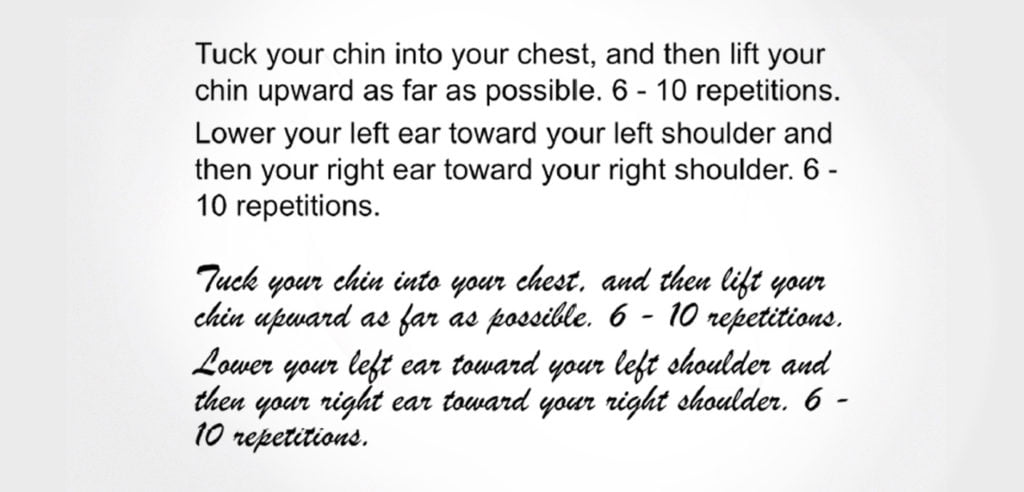
Source: Hyunjin Song & Norbert Schwarz study
In a study, recipients of the hard-to-read text estimated the exercise would take 15 minutes. Those with the easy-to-read text guessed 8 minutes and were more willing to incorporate the exercises into their daily routines.
How Airbnb does it
Without hosts, Airbnb doesn’t exist – and they know it. “Hosting makes Airbnb, Airbnb.” So when a potential host is gathering information about how to make money off their extra space, Airbnb makes information gathering simple.
They do this by using direct messages like, “You can host anything, anywhere,” and lowering the perceived efforts using words like “it’s easy”, “just”, and “try”.
Airbnb also removes barriers during the information gathering process by addressing potential fears a host might have head-on. Such as: “When will my listing appear?” or “How will I attract guests?” or “How do I write a good listing?” They cover all of that in 67 words.

Source: Airbnb
Step 3: Evaluation of Solutions (consideration)
Alright, your product or service is still in the game. Ready to be compared head-to-head with other possible solutions? Step 3 of the consumer buying process is about comparing options.
Step 3 of the consumer buying process is about comparing options.
Logically, the cheaper product or the best product will win. Throw logic out the window and consider solution evaluation from the perspective of an emotional, illogical customer driven by subconscious bias. The winner will most often be the option with the lowest barriers and highest perceived value.
How can you persuade people to choose your product?
There are two components to changing consumer buying behavior: motivation and removing barriers. Motivate people to choose your product by increasing its value and remove barriers by considering what your customers might lose before you consider what they might gain.
Here’s an example of how to do it.
Consumers are more likely to choose the product with a perceived higher value. We’re not talking about higher cost here, but higher value. Consider the labor illusion, an experiment conducted by Harvard researchers that demonstrates consumer preference for products made with “blood, sweat and tears” over fake junk. People value hard work even if it’s not real.
The research compares travel search engines. One search engine showed participants a changing list of partner sites actively being searched, along with an animated calculation of airfare before displaying the results, while another travel search engine showed a white screen as it loaded data.
Even though the competing sites had the exact same loading speed and exact same search results, the website that looked like it was working harder was perceived to provide more value than the “lazy” white screen website.
60% of participants in a Harvard study preferred waiting longer on a site that appeared to be putting in more work over a site that displayed instant results. It merely delivered more perceived value to its customers.
In fact, 60% of participants in this Harvard study preferred waiting longer on the site that appeared to be putting in more work over the site that displayed instant results. And the funny thing is, the site with the clever animation wasn’t actually working any harder at all. It merely delivered more perceived value to its customers.
The key here is to show value where value can’t be seen or observed. People can’t look at your website’s code and see the hidden value. But they can look at an animation of costs being calculated and perceive value from that.
Another way to increase perceived value is to simply describe things. Tell customers explicitly about the manufacturing process — who’s doing it? Where do they work? Under what conditions? Do they like their jobs? Are they paid fairly?
The purpose of describing things in detail is not to educate the customer, but to show the value of the product when that value is an intangible thing. Paint a picture in the mind of the customer to help them understand the work, love, ethics, and commitment that go into your product or service.
How Patagonia does it
Anyone sporting Patagonia gear knows they’re not just wearing any old jacket or backpack. They’re wearing an environmental solution whose endgame is saving our planet. They’re wearing the hard work of those who are paid fairly and treated with dignity and respect. To them, they’re wearing something valuable beyond the fabric and threads around their legs.
Patagonia does a fantastic job of increasing perceived value by describing, in great detail, the “behind-the-scenes” effort that goes into their products. Because customers aren’t able to sit in the factory and assess the quality of the work and fairness of the labor, Patagonia goes to great lengths to describe this process to them directly.
This pair of pants is no longer a pair of $100 pants to be evaluated alongside another pair of pants. These pants become more valuable once a customer knows how they were made, by whom, and the impact their creation has on the environment. For a Patagonia customer, these descriptions create immense value.

Source: Patagonia
Other aspects to consider
Visual content
As we mentioned earlier, visual content is what rules today’s market. Each of us enjoys looking at the nice displays when we’re walking down the street, right? If you sell your product online, you should approach it the same way.
Presentation is the key. If you want to create that wow effect with your product, put in effort, and capture their attention with great-looking photos.
Ratings and reviews
A whopping 97% of consumers read reviews, and depend on ratings before making a purchase. This shows the importance of including authentic reviews of your products. But whatever you do, don’t make the mistake of thinking that you can game the system with fake, shady, or paid reviews.
To gather more reviews, actively ask for your customers’ opinions and let them give you feedback. The reviews and ratings should be well organized, and easy to navigate and read.
Questions & answers
There’s always room for questions, even if you think you covered and explained everything in your product description. Make sure you’re available to your potential customer, and provide an easy way to contact you with any enquiries.
Your presence improves their journey, and gives them the confidence and assurance that the product they’re interested in comes straight from your company.
Step 4: Purchase (conversion)
Finally, the customer is on the brink of buying. After identifying a problem, researching solutions, and comparing those solutions, a purchase can be made. But the party’s not over yet, folks. The fat lady has yet to sing.
Let’s say the customer has evaluated your product or service as the most valuable choice. They could still drop out of the purchase decision if your website is running slow, if the checkout process is complicated, or if lingering uncertainty has not been removed. Uncertainty and subconscious barriers can be the biggest sales killers at the end of the consumer buying process.
With the mechanics of checkout sorted — mobile optimized websites, easy-to-use POS systems for tellers, clear payment options — there are deeper psychological elements at this near-final stage of the consumer buying process that will help you secure the sale.
How to secure the sale?
So far you’ve played all your cards right. But the deal ain’t in the bag until you put it in their bag. Make customers feel like they already own what you want them to buy. A sense of ownership makes something even more valuable than it is. That’s the endowment effect. When used properly, it can make a person feel like they’ll lose something if they don’t make a purchase.
If customers can imagine what it would be like to own your product, then they’re more likely to feel a loss if they don't make it theirs.
The idea of possession alone can stimulate the endowment effect. If customers can imagine what it would be like to own your product, then they’re more likely to feel a loss if they don’t make it theirs.
Try on the dress. Touch the computer. Taste the ice cream. Make the customer feel as if they already own it. Let them imagine what life would be like if they made a purchase. Test drive the Porsche.
Alternatively, you can frame a discount in such a way that if the customer were not to take advantage of it, it would be seen as flushing their money down the drain. That’s exactly what Uber does. Instead of telling riders they can get 30% off their next ride, they let them know the credit has already been loaded onto their account. All they need to do is activate it.
It’s money just sitting there. Free money. It would be a shame to lose it. Nobody thinks of a discount as something that’s owned, but if the endowment effect is employed properly, an unused discount will feel like money lost.
In addition to the endowment effect, you should also use anchoring to instill a psychological motivation in your customers to purchase something. The first number a consumer hears will give them an anchor to base their purchase decision on. No matter how untrue or unreasonable this first number might be or sound, it will become ingrained in the consumer’s mind like an anchor and have major influence on consumer decision-making process.
Anchoring
People’s tendency to rely and base their decisions on the first piece of information (often number) offered. The anchor creates a reference point to which people compare other prices.
The anchor effect works mentally on numbers in a few different ways. It can be a price value that gets anchored in your mind. Or it can be a limit on the number of items you can purchase.
If a car is initially offered to you at $22,000 — the anchor — but then the sticker price is lowered to $19,000, it feels like you’re getting a good deal. That initial anchor got you hooked and no matter what, it doesn’t go away.
Even more psychologically sneaky is the quantity anchor. Tell people a specific number to buy, or limit your purchase to a maximum amount. Once that number is anchored in the consumer’s mind, they have a tendency to think of that number as the right amount to purchase and will purchase closer to that limit.
KFC used anchoring to increase sales of french fries by 56% YOY. Instead of pitching the great limited time offer — dollar fries — they anchored a number into customer’s minds of how many they could and should buy. Instead of talking about a price point — oh wow, these fries are only one dollar! — people were talking about ways to scheme the system of four — if I go through the drive-thru twice, can I get six?
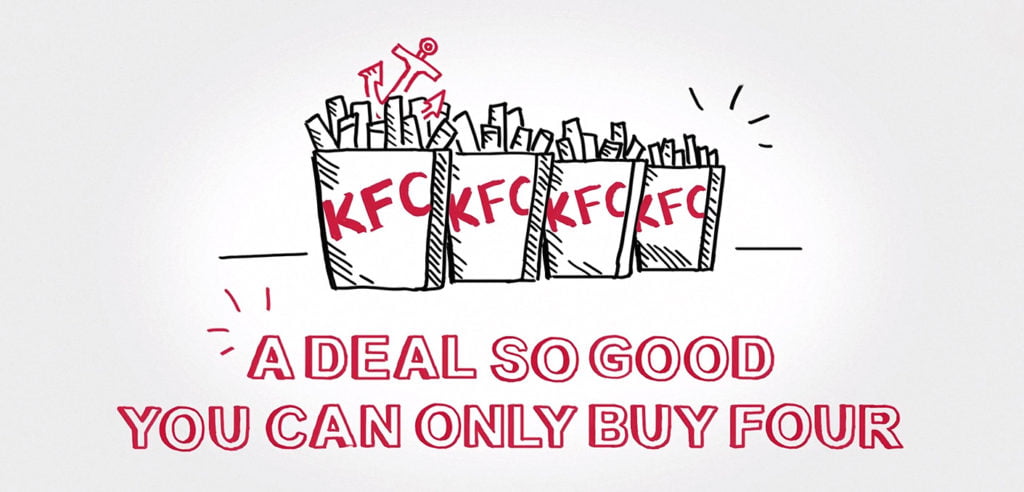
Source: Ogilvy Asia
Behavioral economics is rife with secrets to getting the sale. Like how Zara uses the “Ikea effect” in online shopping to make customers see it through to the Buy Now button. Or how an insurance company removed barriers through email copy alone to triple conversion rates.
The endowment effect and anchoring are just two of many ways to nudge people towards making a purchase. It’s essential to map out your particular customer journey and find those pain points that are specific to your offering. You must determine what the barriers are and apply the best behavioral principle to remove them: e.g. social proof, loss aversion, anchoring, the endowment effect, fairness, choice overload, etc.
How Apple does it
If only to steal the free Wifi, we’ve all lurked around an Apple store. That’s exactly what they want you to do. Apple deploys the endowment effect to help you make a purchase. Just short of sending everybody home with a free sample iPhone, Apple wants you to imagine your life with their products. So they put their products directly in your hands.
And the products they put in your hands aren’t limited editions. They’re fully functioning phones, laptops, tablets, and desktops that are connected to the internet and there for you to play around with. By feeling as if you already own the product, Apple pushes customers over the line to the point of purchase.
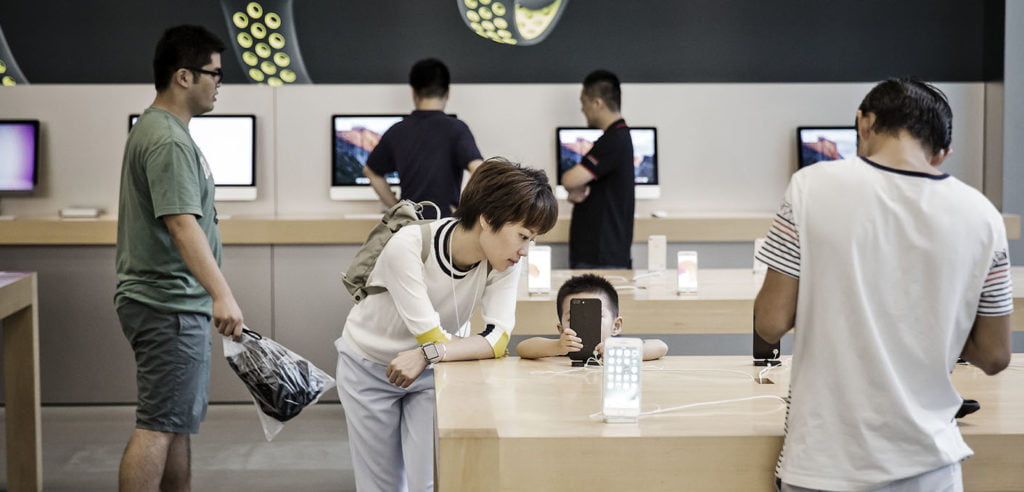
Source: Apple
Step 5: Post-Purchase (re-purchase)
The sale’s been made, time to pack up and head home, right? Wrong. The buying process doesn’t end the moment a customer makes a purchase. We want them to purchase it again, and most importantly, to feel good about their decisions. That’s why the final step of the consumer buying process is post-purchase.
What happens often is something called buyers remorse — after a customer buys something, they start questioning their decision later. As a marketer, you have to anticipate this and provide the customer with an experience that will make them feel happy with their decision.
An important thing to note is that a purchase confirmation can of course be evoked by marketers, but ultimately this satisfaction must be realized by the customer themselves. They must feel as if they’ve arrived there on their own accord without psychological manipulation. Just pure happiness with a decision well-made.
How can you help people feel good about their purchase?
The post-purchase phase of the consumer buying process is a bit of a contradiction. The person has already paid for the item. The transaction is complete. Yet they still seek information about the product and the company they just purchased from. Why is that?
A few reasons: cognitive dissonance feels icky, and we all need a sense of closure.
Once we’ve made a decision — from purchasing a house or a pair of pants to booking a trip to Thailand or voting in an election — our brains selectively seek information that reinforces the decision we’ve just made.
Help your customers reduce or avoid cognitive dissonance by making this reaffirming information readily available. This might be in the form of other customer reviews, a thriving community on social media, or simply a follow up email thanking them for their purchase.
This process is an innate human instinct — we don’t want to be wrong about what has already been chosen so we seek out information that affirms we are right.
A study by Georgetown Institute for Consumer Research found that 78% of consumers sought out information about a brand or product after their purchase. And 67% of those people agreed that they were looking for information to reaffirm their purchase decision.
As a marketer, it’s your job to reduce or avoid cognitive dissonance in your customer’s mind. Pat them on the metaphorical back and tell them, “Job well done. You chose wisely by choosing us.”
In addition to post-purchase marketing activities like a simple thank-you email or card, marketers can direct customers towards closure.
Closure is something we seek for relationships gone wrong or a sudden dismissal from a job. It seems like a silly thing, closure, for such a simple decision like buying chocolate. But research shows consumers also want closure after they’ve made a purchase decision. Self-created closure enacted by the consumer themselves increases satisfaction.
In this experiment, researchers asked people to choose from an assortment of 24 chocolates placed in a glass cake dome. In one instance, people were asked to immediately try the chocolate. In a second instance, people were asked to first put the glass dome over the other chocolates before tasting the chocolate they had chosen. People were more satisfied by the chocolate they had chosen when the other unchosen chocolates were covered by the glass dome.
People who created a physical barrier — the glass dome — between themselves and other choices were less likely to regret the choice they had just made. And they enjoyed their chocolate more.
The research notes an important distinction about who creates the closure. The act of closure must be performed by the decision maker rather than someone else. It’s your job as a marketer to facilitate closure, but let the customer take action themselves. Let them put the lid on the chocolate.
Facilitate choice closure by creating a physical space between the shopping floor and checkout stands. As people walk away from rejected choices to pay for their chosen items, that physical distance can act as a positive reinforcement of the purchase decisions they’ve made.
In the e-commerce world, choice closure can be facilitated by making customers cancel times they’ve viewed but ultimately decided not to buy. Visual cues support choice closure in a similar way as physical actions. Clicking a red X on a checkout page further identifies YES items and NO items. It makes that final purchase decision feel more secure.
How Smiley Socks does it
Smiley Socks provides customers with a positive post-purchase experience with a nice reassuring message that they’re a good decision-maker. As a bonus, they double down with the endowment effect by giving you a free gift with your next purchase. Too good not to shop again.
This simple post-purchase letter makes customers think, “Wow, what a thoughtful company. They appreciate my business and I made a good decision to buy from them.”
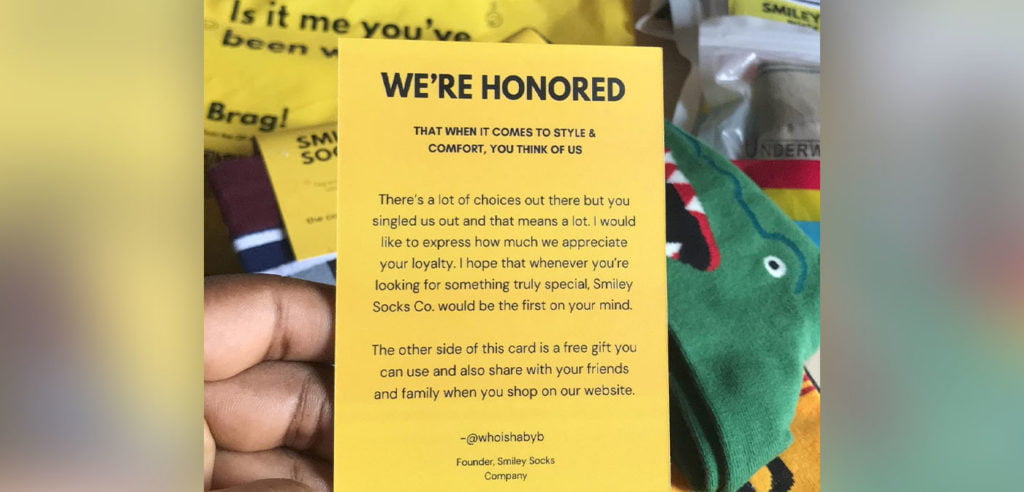
Source: Smiley Socks
Summary
- Much of the consumer buying process happens on a subconscious level. Thinking of the process in the context of behavioral principles helps marketers tap into deeper triggers that make people want to buy.
- Removing barriers is at least as equally effective at changing behavior as adding motivation. Uncertainty, especially at the purchase phase of the buying process, can be one of the biggest sales killers. Find all the reasons to buy and all the reasons not to buy and adapt your offering accordingly.
- Behavioral economics is loaded with ways to influence the consumer buying process. Educate yourself on techniques like anchoring, social proof, the endowment effect, and barriers by reading examples of how other companies have succeeded and failed at applying them. This exposure will support the application of these behavioral principles to your own use cases.

